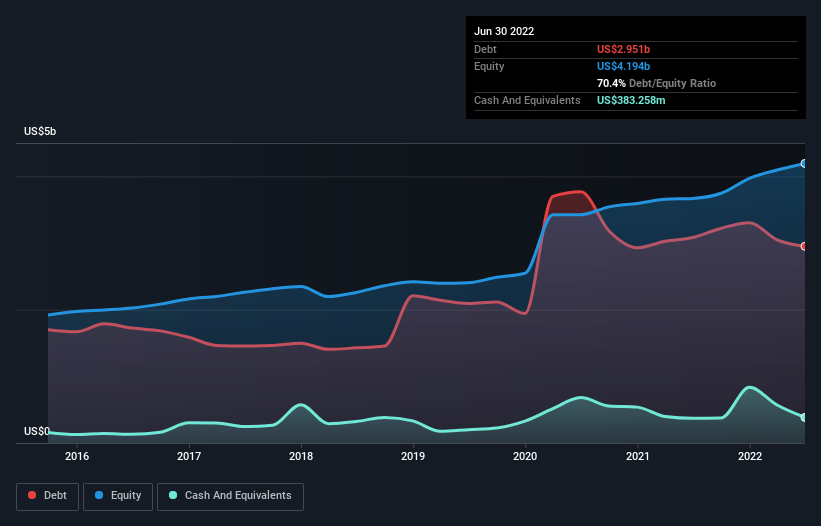
David Iben put it well when he said, 'Volatility is not a risk we care about. What we care about is avoiding the permanent loss of capital.' So it seems the smart money knows that debt - which is usually involved in bankruptcies - is a very important factor, when you assess how risky a company is. Importantly, Taylor Morrison Home Corporation (NYSE:TMHC) does carry debt. But the more important question is: how much risk is that debt creating?
When Is Debt A Problem?
Debt assists a business until the business has trouble paying it off, either with new capital or with free cash flow. In the worst case scenario, a company can go bankrupt if it cannot pay its creditors. While that is not too common, we often do see indebted companies permanently diluting shareholders because lenders force them to raise capital at a distressed price. Of course, plenty of companies use debt to fund growth, without any negative consequences. When we think about a company's use of debt, we first look at cash and debt together.
See our latest analysis for Taylor Morrison Home
What Is Taylor Morrison Home's Net Debt?
As you can see below, Taylor Morrison Home had US$2.95b of debt at June 2022, down from US$3.08b a year prior. However, it also had US$383.3m in cash, and so its net debt is US$2.57b.

A Look At Taylor Morrison Home's Liabilities
Zooming in on the latest balance sheet data, we can see that Taylor Morrison Home had liabilities of US$1.01b due within 12 months and liabilities of US$3.45b due beyond that. Offsetting this, it had US$383.3m in cash and US$171.7m in receivables that were due within 12 months. So it has liabilities totalling US$3.90b more than its cash and near-term receivables, combined.
Given this deficit is actually higher than the company's market capitalization of US$3.06b, we think shareholders really should watch Taylor Morrison Home's debt levels, like a parent watching their child ride a bike for the first time. Hypothetically, extremely heavy dilution would be required if the company were forced to pay down its liabilities by raising capital at the current share price.
We measure a company's debt load relative to its earnings power by looking at its net debt divided by its earnings before interest, tax, depreciation, and amortization (EBITDA) and by calculating how easily its earnings before interest and tax (EBIT) cover its interest expense (interest cover). The advantage of this approach is that we take into account both the absolute quantum of debt (with net debt to EBITDA) and the actual interest expenses associated with that debt (with its interest cover ratio).
Taylor Morrison Home's net debt to EBITDA ratio of about 2.1 suggests only moderate use of debt. And its strong interest cover of 90.8 times, makes us even more comfortable. It is well worth noting that Taylor Morrison Home's EBIT shot up like bamboo after rain, gaining 98% in the last twelve months. That'll make it easier to manage its debt. The balance sheet is clearly the area to focus on when you are analysing debt. But ultimately the future profitability of the business will decide if Taylor Morrison Home can strengthen its balance sheet over time. So if you want to see what the professionals think, you might find this free report on analyst profit forecasts to be interesting.
Finally, a company can only pay off debt with cold hard cash, not accounting profits. So we clearly need to look at whether that EBIT is leading to corresponding free cash flow. Over the last three years, Taylor Morrison Home recorded free cash flow worth a fulsome 85% of its EBIT, which is stronger than we'd usually expect. That puts it in a very strong position to pay down debt.
Our View
Taylor Morrison Home's interest cover was a real positive on this analysis, as was its conversion of EBIT to free cash flow. But truth be told its level of total liabilities had us nibbling our nails. When we consider all the elements mentioned above, it seems to us that Taylor Morrison Home is managing its debt quite well. Having said that, the load is sufficiently heavy that we would recommend any shareholders keep a close eye on it. There's no doubt that we learn most about debt from the balance sheet. But ultimately, every company can contain risks that exist outside of the balance sheet. To that end, you should learn about the 2 warning signs we've spotted with Taylor Morrison Home (including 1 which can't be ignored) .
Of course, if you're the type of investor who prefers buying stocks without the burden of debt, then don't hesitate to discover our exclusive list of net cash growth stocks, today.
Valuation is complex, but we're here to simplify it.
Discover if Taylor Morrison Home might be undervalued or overvalued with our detailed analysis, featuring fair value estimates, potential risks, dividends, insider trades, and its financial condition.
Access Free AnalysisHave feedback on this article? Concerned about the content? Get in touch with us directly. Alternatively, email editorial-team (at) simplywallst.com.
This article by Simply Wall St is general in nature. We provide commentary based on historical data and analyst forecasts only using an unbiased methodology and our articles are not intended to be financial advice. It does not constitute a recommendation to buy or sell any stock, and does not take account of your objectives, or your financial situation. We aim to bring you long-term focused analysis driven by fundamental data. Note that our analysis may not factor in the latest price-sensitive company announcements or qualitative material. Simply Wall St has no position in any stocks mentioned.
About NYSE:TMHC
Taylor Morrison Home
Operates as a land developer and homebuilder in the United States.
Very undervalued with flawless balance sheet.
Similar Companies
Market Insights
Community Narratives


